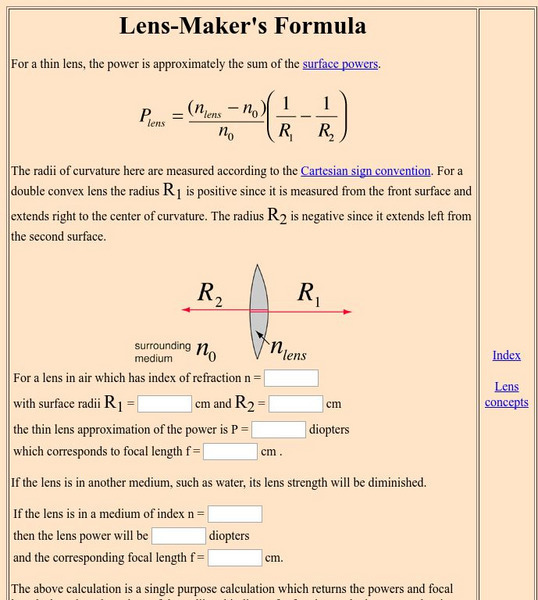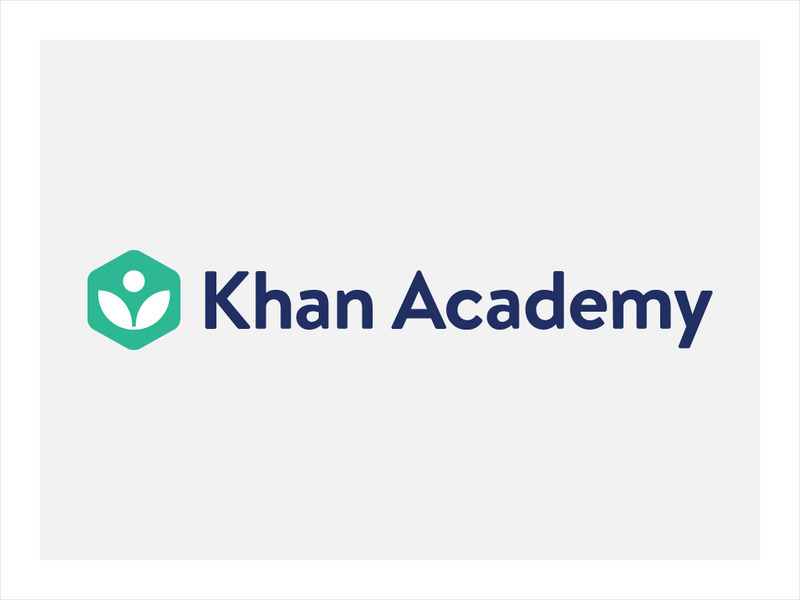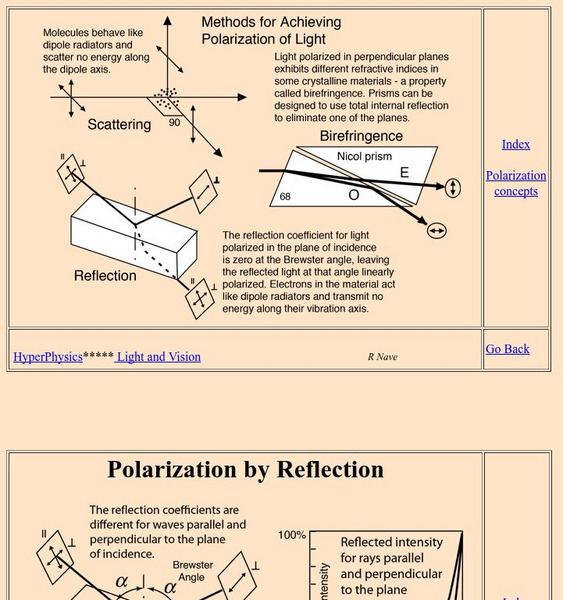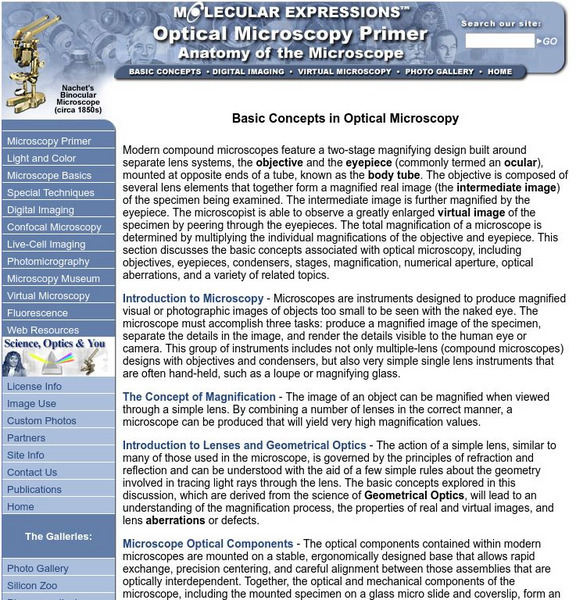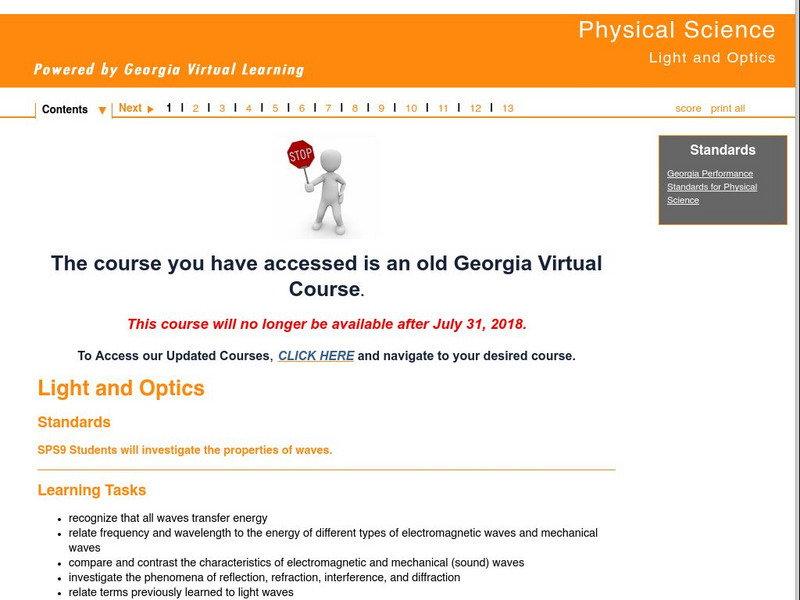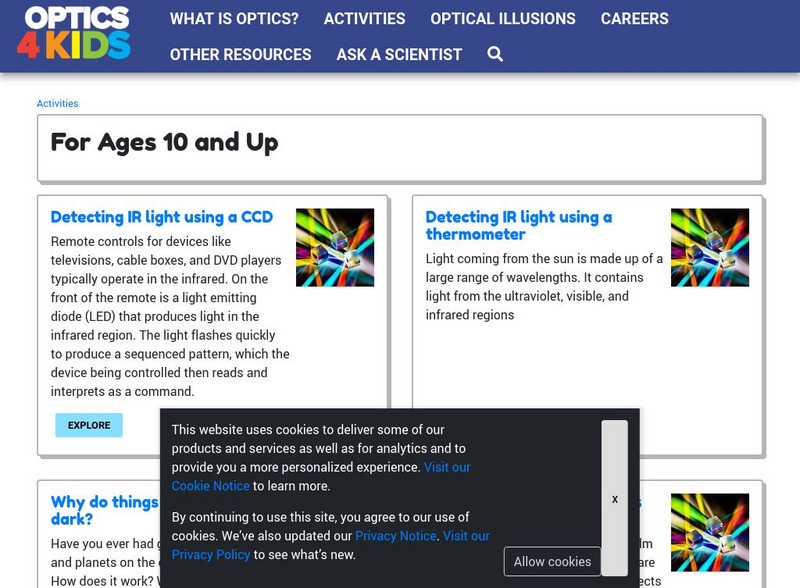University of Chicago
Telescopes at Yerkes Observatory / Virtual Tour
This site describes the difference between reflective and refractive telescopes and includes a virtual tour of Yerkes Observatory which houses the largest refracting telescope in the world.
University Corporation for Atmospheric Research
Ucar: Measuring Density by Bending Light
Students observe how different materials bend light, and how we can infer the nature of the material based on the amount it bends light rays.
NASA
Nasa: Build a Telescope
This simple lesson plan outlines how to build refracting telescopes and calculate their magnification. Use the follow up lab questions to check for student understanding and view links to other NASA lesson plans.
TeachEngineering
Teach Engineering: Show Me the Genes
In this activity, students create posters which explain and illustrate thin film refraction and the factors that influence it. The goal is to explain the experimental results of using an optical biosensor, and prove these results with a...
Georgia State University
Georgia State University: Hyper Physics: Lens Maker's Formula
A discussion of the lens-maker's formula and its use in determining the effect of lens shape and index of refraction upon the magnifying power of a lens. Includes an interactive problem-solving section.
Khan Academy
Khan Academy: Eye Disease and Contact Lenses
Punctate keratitis is an eye disease that results in abrasions on the epithelial cornea. One of the leading causes of the disease is the overuse of contact lenses. A research team is investigating the optical properties of four new types...
TeachEngineering
Teach Engineering: Stations of Light
Student groups rotate through four stations to examine light energy behavior: refraction, magnification, prisms and polarization. They see how a beam of light is refracted (bent) through various transparent mediums. While learning how a...
Utah Education Network
Uen: Enlightening Explorations, Part Iii
This lesson contains the following labs: Rainbows, Refraction with Prisms, and What Color Is It? Students will study light by reading various nonfiction texts and viewing a video lesson. Then students will engage in the following labs:...
Georgia State University
Georgia State University: Hyper Physics: Methods of Polarization
At this college physics department site, the polarization of light is explained and illustrated as well as the primary methods of polarization (scattering, reflection, and refraction).
Georgia State University
Georgia State University: Hyper Physics: Microscope
This site from Georgia State University Physics Department provides a discussion of how light refracts through the lenses of a microscope. Demonstrates the parts of a microscope and includes an interactive form in which the magnifying...
Florida State University
Florida State University: Microscopy Primer: Anatomy of the Microscope
The premier web site on the physics of microscopy. Includes several pages and numerous Java applets about microscopes and refraction. Thorough, well-illustrated, interactive, fun, and educational. What more can one ask for?
CK-12 Foundation
Ck 12 Exploration Series: Simulations: Physics: Diamond Cut
[Free Registration/Login Required] A simulation investigating why a diamond shines by looking at refraction, reflection, and total internal reflection.
Georgia Department of Education
Ga Virtual Learning: Physical Science: Light and Optics
Students will investigate the properties of light waves. They will learn about the different types of electromagnetic waves and mechanical waves, and investigate the phenomena of reflection, refraction, interference, and diffraction.
American Museum of Natural History
American Museum of Natural History: Ology: See the Light
Reflection, refraction, and the colors that make up white light is explored through lab activities after reading a brief background about light energy.
University of New South Wales (Australia)
University of New South Wales: School of Physics: Physclips: Geometrical Optics
Physiclips thoroughly presents geometrical optics concepts like rays, refraction, Snell's law, total internal reflection, dispersion, mirrors, and lenses with animations and film clips.
University of Colorado
University of Colorado: Ph Et Interactive Simulations: Geometric Optics
An interactive simulation that teaches about refraction, lens, and optics. Students manipulate the focal length of the lens, and move the object, lens, and screen in order to see how the image is affected. This simulation can either be...
Exploratorium
Exploratorium: Science Snacks: Giant Lens
A discussion of how to make a refraction exhibit using a Fresnel lens. Consists of assembly instructions and a "To do and notice" section.
University of Colorado
University of Colorado: Ph Et Interactive Simulations: Bending Light
Explore bending of light between two media with different indices of refraction. See how changing from air to water to glass changes the bending angle. Play with prisms of different shapes and make rainbows.
TeachEngineering
Teach Engineering: Learning Light's Properties
Students learn the basic properties of light--the concepts of light absorption, transmission, reflection and refraction, as well as the behavior of light during interference. Lecture information briefly addresses the electromagnetic...
ClassFlow
Class Flow: What Is Light?
[Free Registration/Login Required] This flipchart reviews the characteristics of light and its properties. Students are given examples of reflection, refraction, and lens types. An assessment component is included.
Utah Education Network
Uen: I'm So Bright! I Wear My Shades Indoors!
This lesson engages students in learning about light through multiple sources. Students will learn how light is produced, reflected, refracted, and separated. Students will communicate their findings through an independent project that...
Utah Education Network
Uen: Enlightening Explorations, Part Ii
This lesson engages students in learning about light. Studets will describe how light is produced, reflected, refracted, and separated.
Optical Society
Optical Society of America: Exploring Science of Light: Intermediate Activities
A collection of intermediate experiments, for students aged ten and up, for exploring the magnification, reflection, and refraction of light.
CK-12 Foundation
Ck 12: Wave Properties
[Free Registration/Login may be required to access all resource tools.] Students investigate behaviors of waves, including interference, reflection, refraction, and diffraction.
Other popular searches
- Light Refraction
- Reflection and Refraction
- Light Reflection Refraction
- Refraction of Light
- Index of Refraction
- Reflection Refraction
- Science Light Refraction
- Absolute Index of Refraction
- Wave Reflection Refraction
- Diffraction and Refraction
- Light Refraction Water
- Angle of Refraction




